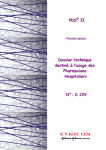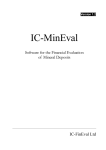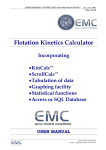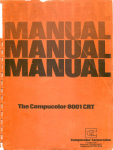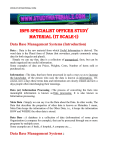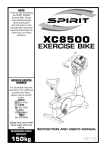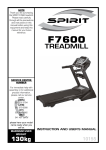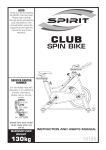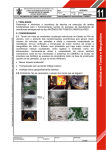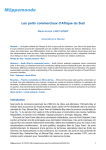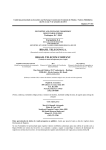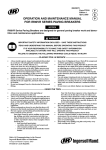Download April 2003.p65
Transcript
IN THIS ISSUE 4 Drive system for mine hoists A new ABB drive using Direct Torque Technology has been used successfully for various mine hoist applications over the last 1.5 years. This new generation of drives offer unequalled speed and torque control performance, as well as low impact on the supply network. in 12 Simplicity controls A recent US survey clearly indicated the four most desired features of an AC drive. Simple control and setup came out tops, while convenient operator interface, programmability and pricing were also important. 14 9 Eliminating harmonic distortion The latest regenerative four-quadrant ABB drive offers huge cost savings in industrial power supplies. The physically small drive – up to 80% smaller than alternative units – uses a combination of patented technologies to remove the need for expensive multi-pulse diode rectifiers. Mill starting ABB has taken the guesswork out of mill starting with the design of a tool that can calculate all the relevant parameters for a range of mill applications which use wound rotor induction motors with liquid resistance starters. We have a winner! In the previous issue of ABB Technology Solutions we invited our readers to enter a lucky draw. Congratulations to Margie Kotze from GFJ who is the lucky recipient of a LAMY Logo fountain pen. The pen is kindly sponsored by W Vos & Company (Pty) Ltd, distributor of LAMY Writing Instruments. Tel: +27 11 493-7193 TECHNOLOGY SOLUTIONS is published by ABB South Africa. Address: ABB Park, 3 Eglin Road, Sunninghill Postal: Pvt Bag X37, Sunninghill, 2157 www.abb.com/za Telephone: +27 11 236-7000 Facsimile: +27 11 236-7001 Managing Editor: Chesney Bradshaw [email protected] Editorial Panel Richard Becker [email protected] Andrew Williamson [email protected] Shivani Chetram [email protected] Ntaga Mojapelo [email protected] Willie Zeelie [email protected] Jacqueline Burn [email protected] This publication was designed, compiled and produced on behalf of ABB South Africa by M&M Publications (Pty) Ltd. PO Box 1644, Saxonwold 2132 Johannesburg, South Africa. Tel: +27 11 880-5790 Fax: +27 11 880-5789 E-mail: [email protected] Whilst the compilation and production of ABB Technology Solutions is done with great care and attention and every effort is made to prevent mistakes, neither ABB in Southern Africa nor its principles or subsidiaries, nor M&M Publications (Pty) Ltd. accept responsibility for any errors or the consequences thereof. 2 APRIL 2003 NEWS BRIEFS & EDITORIAL new developments Sappi chooses IT Direct Drive ABB has received an order to supply an Industrial IT Direct Drive system for Sappi Kraft’s number four paper machine at its Tugela Mill in Kwazulu-Natal. The system represents new direct drive technology, which is becoming the industry standard in drive systems. The contract, valued at nearly R26 million, includes the delivery of 24 drive sections, 17 permanent magnet motors and seven standard asynchronous motors without gearboxes, as well as application software and all related services such as cabling, installation, commissioning and training. “ABB’s Direct Drive will enable Sappi to reduce the total life-cycle costs of operating the paper machine,” says Urs Leuenberger, Technical Director, Automation Technologies division, ABB South Africa. “The unique solution reduces mechanical components in the paper machine drive, thereby simplifying it and giving it improved running efficiency and cost of ownership.” The solution is based on the new permanent magnet motors, frequency converters and application software. The drive system uses direct drive philosophy, which encompasses the use of permanent magnet motor technology to provide good torque at low speeds to eliminate the need for gearboxes. The start-up of the paper machine is scheduled for August 2003. Bringing new technology to customers ABB recently took a giant leap in bringing new technology to its customers by hosting its customer open days in Richards Bay and Durban for the first time. The event, aimed at keeping customers informed about new products and technology within ABB, was well staffed with ABB’s technical and marketing personnel. The open days were of interest to all industries – utilities, process industries, manufacturing and consumer industries and oil, gas and petrochemical fields. Products from various divisions were exhibited and guests were given the opportunity to attend on-going presentations and hands-on demonstrations. The exhibition, attended by over 200 customers, included the launch of ABB’s new ACS 800 Low Voltage Drive family. ABB increases presence in PE ABB has consolidated and expanded its representation to customers in the Port Elizabeth area and positioned itself to support the growing automotive industry and other industrial initiatives such as Coega. The company recently relocated its automotive, robotics, and low voltage and medium voltage products businesses to the new office at Newton Park, bringing them together to provide a complete offering to customers. “Our stronger presence in this area will allow us to focus better on our customer’s needs in the growing automotive industry and provide them with improved access to international power and automation technologies,” says Per Wanland, senior vice president at ABB South Africa. ABB ranks high in reputation stakes ABB was recently ranked highly in the “World’s most respected companies” report, run by the Financial Times and PriceWaterhouse Coopers. The study comprised interviews with 1000 senior executives and opinion formers in 20 countries. In the engineering sector ABB was placed third (Toyota was first and General Motors second), one place down from the second spot in 2001. Of all the global companies listed, ABB was ranked in the top 50 as one of the world’s most respected companies. The group’s position was No. 33, well ahead of its competitors. In the business leader category, ABB’s president and CEO, Jürgen Dormann, was ranked in the top 50. ABB also featured strongly in the categories of companies making the most impact on economic and social issues in emerging markets and companies that best manage environmental resources. Committed to innovation O ver the years, ABB South Africa has used its knowledge and expertise to achieve excellence in power and automation technologies. Through innovative solutions, we have remained committed to providing our customers with superior and competitive products and services. To this end we continue to invest in our eight factories located throughout South Africa by installing new technology and production systems. Social responsibility On the Corporate Social Responsibility side, ABB has shown its commitment to South Africa in a number of different ways. We have invested in several sustainable projects nationwide in order to empower local communities. We are a black economic empowerment company, with 20% of our local holding company being owned by WIPHOLD, a financial services company run and owned by black women. “ ABB South Africa is committed to providing its customers with superior and competitive products and services. ” Through these efforts, we at ABB strive to put our customer first, bringing them the best technology and service in order to help them prosper in their business ventures. Carlos Poñe President and CEO ABB South Africa. APRIL 2003 3 DRIVE TECHNOLOGY New drive system for mine hoists The new drive introduced by ABB using Direct Torque Control (DCT) is now proven technology for mine hoist applications, and has already had more than 1.5 years of service. starters. This type of drive was not suitable for automatic hoisting systems. Introducing DC-technology with Ward-Leonard technology was a big step in drive technology, providing excellent speed and torque control of the hoist motor. The introduction of thyristor convertor technology exposed the drawbacks of the WL system. The space saving thyristor convertor replaced the DC generator as well as its driving AC motor. The capital expenditure was reduced and the operating efficiency largely improved when the thyristor technology was introduced in the mid 1960s. The main drawbacks of thyristor convertor technology, reactive power and harmonics generation, were dealt with by the installation of tuned filters. The voltage fluctuations in installations with weak power supply could only be solved by installing expensive rotating synchronous condensor or a static VAR unit, SVC. Looking back The headframe of the Pyhasalmi Mine in Finland. T he first installation in the Pyhasalmi mine in Finland uses MV technology with an ACS 6000 SD drive and synchronous motor. ABB has also installed two hoists in the Kemi mine in Finland with LV technology and induction motors for two hoists using the ACS 600 drive with high speed induction motors. ABB’s new generation of drives offer unequalled speed and torque control performance, as well as low impact on the supply network by controlling the power factor to unity with a minimum of harmonics distortion. Changes in technology Drive technology for mine hoists has seen many changes over the past decades. The first electric solution widely used was the induction motor with resistor banks in the rotor circuit. It provided controlled acceleration and retardation by using variable secondary resistance using switching contractors or liquid 4 APRIL 2003 For the sake of completeness of this summary, the predecessor or thyristor, the mercury arc rectifier, was successfully introduced earlier but never captured major market share. Thyristor technology then dominated the market for almost two decades until cyclo-convertor technology was introduced.The main driving factor for the development of the cyclo-convertor was the increased cost of DC machines. The demand for DC machines has been drastically reduced with the abandoning of the WL system, eliminating the need for the DC generator. The largest market of DC machines, rolling mill applications, required fewer new large motors as the number of new mills decreased, and thinner metal could be produced by modern continuous casting methods. For a few years during the mid 1980s the cyclo-convertor and the synchronous motor captured the market for large mine hoists. Smaller hoists were still using DC-drives. The combination of high speed DC motors and gearbox gives the lowest capital expenditure for power trains up to about 1500 kW. Paradigm shift However, a paradigm shift to new AC technology is underway, also for this power range. Cyclo-convertor technology became a financially competitive alternative to the DC solution. However, the negative influence on the network side was more severe than caused by DRIVE TECHNOLOGY Control of ACS 6000 SD The difference between a conventional Pulse Width Modulation (PWM) drive and the Direct Torque Control (DTC) of ACS 6000 is illustrated in the figures below. The control is made in the Control Unit (COU). Flux vector control DTC-control ARU ISU V Speed control Torque control Speed control Modulator Torque control f INU M PG M PG 3 3 The PWM has a modulator module that determines the pulse pattern. This computation is very time consuming and slows down the motor control. The DTC drive control has eliminated the modulator. Instead, the torque controller acts directly on the gate control unit. As the program allows the gate control circuit to be updated 40 000 times every second, extremely fast torque control is achieved. DC. Because the cyclo-convertor produces more complex harmonics than the corresponding DC drive it became more costly to meet the requirements of the power utilities. Add to these new demanding requirements on power quality, the drawbacks of both DC and cyclo-convertor drives became major issues. Reactive power is today not a free issue but a real operating cost parameter. Equally important cost issues are total harmonic distortion (THD), flicker and telephone interference factor (TIF). Even elaborate and expensive fixed filters will not satisfy power quality requirements in normal mine environment. Today, not only are the requirements of the power utilities stringent, but the internal consumers of electricity in the mines are demanding. Computers and instrumentation, as well as human resources make the mine spend large amounts on improved power quality. Voltage drops and voltage variations caused by obsolete technology requires expensive voltage support systems. There is also strong demand for improved performance of the power train such as speed and torque control in particular in rolling mill applications to enable higher quality of finished steel products. To satisfy the requirements for higher drive performance and higher network quality, ABB has developed a new generation of drives. Two basic product series are available, ACS600 for LV and ASC6000 for MV systems. Main components of ACS6000 SD The main components of the ACS 6000 SD drive starting at the motor side are: INU, EXU, ARU, IFU, CBU including CHU and CLU, COU, WCU. Details: INU, Invertor Unit controls the motor torque and speed in coordination with the EXU, Exciter unit. The power factor of the motor is controlled to unity. The power circuit includes three identical phase modules with IGCT (Intergrated Gate Controlled Thyristor) and diode power semiconductors. The INU generates a motor frequency that for a mine hoist is typically about 10 Hz, or lower at full hoisting speed. EXU, Exciter Unit powers the motor excitation. The convertor is a six-pulse thyristor bridge. ARU, Active Rectifier Unit, supplies power to the CBU unit or in generation mode feeds power from the CBU back to the network. By smart control, the power factor is controlled to unity and the harmonic distortion is minimized. The three phase modules are identical to the INU phase modules. IFU, Internal Filter Unit is needed in some networks to keep the harmonic distortion within the limits specified by IEEE- 519 or IEC 61000-2-4, cl.2 CBU, Capacitor Bank Unit absorbs the ripple currents generated by the ARU and INU units. At start-up of the drive, the capacitor bank needs to be charged before activating the ARU and INU units. This is done by the CHU, Charging Unit using auxiliary power. VLU, Voltage Limiting Unit protects the DC-link against overvoltage. The DC-link has a neutral, a positive and a negative bus providing three-level control of the drive. This means that switching is made from positive to neutral and from neutral to negative and reverse. This increased the speed of the control and reduces the voltage rise dv/dt. APRIL 2003 5 DRIVE TECHNOLOGY Water cooling unit The drive is water cooled. The drive has an internal cooling loop with deionized water. In environments where the temperature might be below freezing point, anti-freeze glycol can be added at the expense of a slight derating of the drive. A heat exchanger is provided. The external cooling circuit can be either plant water or an external water loop with water to air heat exchanger. Advantages The main advantages of the ACS 6000 SD drive with synchronous motor compared to a cyclo-convertor drive using a synchronous motor or induction motor are: z Power factor control: Both the motor and the drive are normally operating at power factor =1. This is the most efficient mode of operation, reducing both losses in the hoisting system and the supply network. z Low voltage drops: Because the power factor is unity, the voltage drop caused on the supply network is reduced to about 20 % of the voltage drop caused by a cycloconvertor or DC-drive. This also means that the new technology allows weaker network meaning less investments in power lines. z Less transformer power required: Since no reactive Flow diagram of the underground operation. 6 APRIL 2003 power is required, the throughput power in the transformers is substantially less than in a cyclo-convertor drive. Typically, the installed transformer power is 50% of what is required for a cyclo. Also, only a single transformer is required. z Low levels of harmonics: The DTC convertor produces low levels of harmonics. Basically, all harmonics below the 25th will be eliminated by the pulse pattern control software. Therefore the normal hoisting installation does not require harmonic filtering to comply with for example IEEE 519 requirements. z Fuse-less design: No fuses or DC-breakers are required in the power circuit. The fast action of the IGCT power semiconductor protects the system against damages at faults. z High efficiency:The synchronous motor has higher efficiency than corresponding DC – or induction motor. Adding to this, lower losses due to less transformer power, fuse-less design and elimination of filters for power factor correction and harmonic suppression, the new technology offers the best total efficiency. Installed base and experiences The mine hoist systems are currently in operation and a third system delivered and under site erection. DRIVE TECHNOLOGY Pyhasalmi mine in Finland The Pyhasalmi Mine started operation in 1962 as an open pit mine. Underground production commenced in 1975 using hoisting systems delivered by ABB. The known reserves were sufficient for operation until about 2001. In the mid 1990s a new deep ore body was found. Further exploration revealed that the ore body contained about 20 million tonnes of copper, zinc and pyrite ore extending the life of the mine by at least ten years. It was decided that a new 1450 m deep shaft should be sunk for a new hoisting system. This makes it the deepest mine in northern Europe. The ramp was extended from the 1000 m level to the 1450 m level. ABB was awarded the contract for the complete hoisting system including the hoisting machinery, skip with cage, counterweight, head-, balance- and guide ropes with attachments. This includes the complete electrical system for power and control. The time schedule for shaft sinking, construction of head frame, design and manufacture of the equipment, installation and commissioning was less than 24 months. The time schedule was kept and production started on 1st July 2001. Below are some highlights of the hoisting system. The hoist room at the Pyhasalmi Mine. Basic hoist system parameters A configuration using combined skip with cage and counterweight was selected. The hoist is a four-rope 4.5 m diameter friction hoist with deflection sheave to match the shaft Water cooled layout. The payload is 21, 5 tonnes and hoisting speed 15,5 m/s. Hoisting distance is 1407 m. Rope guides were selected with fixed guides at loading and dumping. The loading station is provided with a conveyor belt suspended on load cells eliminating the measuring flask. On-line continuous rope tension monitoring is provided in all 6 guide ropes and the four head ropes. The hoist is powered by a 2,5 MW synchronous motor torque and speed controlled by ACS 6000 SD with DTC, Direct Torque Control. The host control system based on ABB Advant technology provides rope oscillation control, ROC, during the hoisting cycle. Operating experience High total availability, 99.7% recorded. More than 20 months of production to date, has verified the design of the system. Reliability and availability tests have been performed as a part of the contract. 4 200 kW synchronous motor at the St. Gotthard tunnel. A test with 12 months duration that was part of the contractual conditions has shown that the total availability of the total hoisting system was 99,7 % which must be considered very high. During this time, there were no disturbances at all related to the drive system including the motor. The six hours or 0.3 % down time was a single fault occasion caused by a ground fault in the hoist control system. The production target for 2002 was exceeded. Sedrun Installation The new St. Gotthard tunnel is currently being built between Switzerland and Italy. The total length will be 57 km. To speed up the project, an 800 m deep shaft is sunk about halfway so that the work can proceed from 4 faces. The shaft is furnished with two hoists, a 4 rope 4.8 m friction hoist with cage and counterweight and an auxiliary single drum hoist. APRIL 2003 7 DRIVE TECHNOLOGY The tunnel will be completed in year 2011. The hoist was taken into commercial operation by the end of 2002. The friction hoist is powered by a 4200 kW synchronous motor controlled by ACS 6000 SD DTC drive. Ongoing deliveryInco-Creighton mine The DC motor of the 5.5 m diameter double drum main cage hoist is reaching the end of its life. Inco investigated several options for continued operation. Repair of the existing motor to improve the insulation was rejected because of the down time required. Different alternatives with a new motor and drive resulted in a decision to select ABB’s new technology with synchronous motor and ACS 600 SD drive. The hoist chamber at the Sedrun installation. Delivery is currently in progress with scheduled change over time in August 2003. Picture below shows the existing installation SD but the power circuit uses IGBT semiconductors instead of with DC motor. IGCTs. ABB has currently two hoists under installation in the Kemi High speed induction motors Chromite mine in northern Finland. The 3.2 m friction hoist at the Kemi Chromite mine with skip + cage and counterweight is powered by a 1500 kW 1000 rpm induction motor with an ACS 600 drive. The DTC technology is available for 690 V systems voltage. The single drum auxiliary hoist is powered by a 75 kW It is available in sizes up to 4730 kVA. The drive ACS 600 is 1000 rpm induction motor with ACS 600 drive. available in both air cooled and water cooled versions. The mine had a preference for AC drive since there are no The system topology of ACS 600 is similar to ACS 6000 previous DC drives in the mine. The hoisting installation is scheduled for completion in August 2003. Conclusion The new drive system, with synchronous or induction motors for mine hoists has brought about advantages, including power factor control, low voltage drops, less transfer power required, lower levels of harmonics, fuse-less design and high efficiency. These advances in technology are being successfully applied to demanding mine operations. Author The Inco Creighton double drum hoist with existing DC motor. 8 APRIL 2003 Börje R Johansson Manager, Sales of Underground Mining ABB Industries AB Tel. +46 -21-340335 Fax: +46-21-185890 [email protected] SIMULATION TOOL Simulation tool for SAG mill starting When a local platinum mine experienced dropped-charge problems a number of experts were consulted to prevent any possible damage to the mill. Now ABB has come up with the perfect solution: a tool that calculates all the relevant parameters for a wide range of mill applications. E ngineers using typical grinding mill applications which involve a wound rotor induction motor (WRIM), gearbox, and liquid resistance starter will know that predicting the speed (and other parameters) during the start is very much a black art, or at very least a case of being forced to use what was used before. A WRIM has the advantage of being able to supply a large range of starting torque by adding external resistance to its rotor circuit. A further benefit is that the motor can supply high torque levels at very much lower currents than an equivalent squirrel-cage induction motor (except if it is driven by a variable speed drive). A typical mill will require a peak torque of approximately 130% of rated torque to start, and since most mining sites have limited supply fault levels, a WRIM is ideal for this application. The basic principle of the start is to vary the external resistance in the WRIM rotor circuit by using a liquid resistance starter (or other resistance devices in some applications). A high resistance causes a low torque and a correspondingly low current, while a low resistance causes a high torque and a correspondingly high current. A good rule-of-thumb guide is that there is a one-to-one ratio between current and torque: 100% starting torque requires approximately 100% starting current (compare this with a typical squirrel-cage induction motor which would require approximately 650% starting current to achieve 100% starting torque). If the external rotor resistance is held constant, the motor torque will still vary considerably with speed. Fig. 2 Fig. 1 Typical simulated mill torque versus angle (rotation) characteristic; the dip at half a revolution is exaggerated for the purposes of simulation conservativeness. Since the motor speed and the liquid resistance change continuously during the start, an accurate prediction of the starting process and its relevant parameters requires a calculation that takes the motor instantaneous torque (and hence speed), the corresponding load torque and the liquid resistance value at each time interval during the start. But whose responsibility is it to combine these parameters and predict the starting process accurately? In most cases, the mill supplier will be able to provide a mill torque versus angle characteristic curve, or a mill torque versus speed curve – assuming constant acceleration. A typical mill torque versus angle function is illustrated in Figure 1. The motor supplier is usually limited to being able to supply a set of characteristic curves of motor torque versus speed – for various external rotor resistances. The liquid resistance starter supplier will supply a characteristic in the form of resistance versus time for various electrolyte concentrations. Ironically, the mill suppliers or engineers have often specified a constant accelerating torque for the start, but this has not been the case. This had not become an issue until recently when droppedcharge problems began occurring at an ABB customer’s platinum grinding mill. A dropped-charge occurs when the mill APRIL 2003 9 SIMULATION TOOL charge does not break up correctly in the mill, but leaves the perimeter of the mill (at a high angle) and drops onto the lower portion of the mill. It is not difficult to imagine what damage a few hundred tons or more of mill charge can do to the mill bearings or the mill structure itself. The problem is new because it appears to be confined to the newer UG2-reef product, as opposed to the original Merensky-reef product. The phenomenon can occur in any mill which is incorrectly operated (loaded) but the possibility is much greater with a ‘stickier’ product such as UG2 – especially if the ball to charge ratio is not high enough. In any event, serious damage was possible to the mill in question if the dropped-charge problem re-occurred, so a number of experts were consulted. The result was a suggested reduction in the initial starting torque by reducing the electrolyte concentration in the liquid resistance starter. When the revised resistance was implemented, the mill exhibited what was considered to be very strange behaviour: It slowed down to such an extent in the first portion of its start that it turned in reverse for some time, but then proceeded to accelerate normally to full speed. Several starts indicated that the revised lower starting torque was certainly less likely to cause a dropped-charge but there was understandable concern over the reversing of the mill during the start. Despite the simultaneous involvement of all the relevant expertise related to the entire mill installation, it became obvious that a method of calculation of the starting 10 process did not exist. It was also equally obvious that a method was required in order to understand and verify what was being witnessed! Since the motor was viewed as the most complex component of the installation, ABB AC Machines in Alrode felt that the rest of the mechanical and electrical system would not be impossible to mathematically couple to the motor, thereby allowing a simulation of the entire system. ABB’s original involvement in the project was as the motor supplier and, since the motor was designed and manufactured at the ABB Alrode factory, all the relevant details were readily available. Significant consultation with the mill suppliers, liquid resistance starter suppliers and project consulting engineers, combined with some fairly detailed spreadsheet programming produced a very useful tool that calculates all the relevant parameters for a wide range of mill applications which use wound rotor induction motors with liquid resistance starters. Typical graphical results from the simulation tool are presented to show the reversing phenomenon when the liquid resistance starter’s electrolyte concentration is reduced to a low level – as witnessed on the plant in question. Figures 2 and 3 show the motor, load and accelerating torque versus time, and the resulting speed versus time for a fairly high (150 %) starting torque. Figures 4 and 5 show the same graphs for a lower starting torque – note the reversing phenomenon in Figure 5 and also the negative accelerating torque in Figure 5. Figures 6 and 7 show the accelerating torque and speed Fig. 3 Fig. 4 Fig. 5 Fig. 6 APRIL 2003 SIMULATION TOOL versus time for a liquid resistance starter set to close its electrodes in 15 seconds, effectively forcing the system to reach full speed in this time. Figures 8 and 9 show the same graphs for the same system but with the liquid resistance starter set to close its electrodes in 30 seconds, slowing down the start. The speed versus time characteristic is effectively the same ‘shape’ stretched over a longer time but there is a significant reduction in the average motor torque and therefore too in its current. The obvious advantage of this feature is to predict the maximum current that will be drawn during a start, for installations where the power system is very weak. Figures 10 and 11 show the flexibility of the tool beyond mill loads: An unloaded fan start has been represented by carefully selected ‘mill’ torque parameters. Note the very different shapes of the graphs compared with those for a typical mill load. Since the simulation tool numerically integrates the relevant parameters in order to predict the starting process, even transients can be approximated with careful manipulation of the variables. Figure 12 shows the transient torques which occur when the short-circuiting contractor closes at the end of the starting sequence. Fig. 7 Author Robert Melaia ABB South Africa – Automation Technologies division Tel: +27 11 617 2000 Fax:+ 27 11 908 2061 Fig. 8 Fig. 9 Fig. 10 Fig. 11 Fig. 12 APRIL 2003 11 DRIVE FEATURES Providing simplicity in controls and set-ups Why is the world demanding drives that are simple to commission? In a survey of 279 US readers, the trade magazine Control Engineering asked what features were most desired in AC drives. S ixty-three per cent responded with a request for simple controls and setups; 45% said they would prefer convenient operator interface; while 45% mentioned programmability and 37% were concerned about pricing. For the past five years, most surveys into what customers want from their drives invariably show these as the four most desired features. And, during this period, manufacturers have been eager to oblige by designing drives, keypads and control panels that offer some very clever and innovative ways to make life easier. Yet, even today – five years on – the surveys still show easy set-up, ease of commissioning and easy to use as the leading demands of today’s customers. So are customers disillusioned with what they are being offered? Are the manufacturers truly hitting the mark? User interface Manufacturers have taken the desire for easy to use drives to heart and have approached the challenge in three ways. Firstly, the user interface itself has been closely scrutinised. Today drive set-ups can be performed quickly using detachable and/or interchangeable keypad interface modules. Most keypad modules can be removed, whether the drive is powered or not. Most companies offer keypads that can be mounted on the drive, as well as used as handheld devices. Keypad modules allow users to programme speed, start, stop, acceleration, deceleration and parameters into the drive. Some modules permit uploads and downloads so that multiple drives requiring the same set-up parameters can be programmed using only one keypad. The parameters for one drive are set with the keypad. Then those parameters are copied into the keypad, which is taken to other drives for subsequent setups. The user then downloads the setup parameters from the keypad into each drive in succession. These devices normally feature liquid crystal display (LCD) readouts. The readouts show speed information, setup parameters, or error codes. Secondly, manufacturers have been looking at the best way for the user to interface with the keypad and this has resulted in an array of push buttons, potentiometers, knobs and digital scroll dials. But perhaps the biggest challenge has been improving the quality of the actual data that is presented to the user and simplifying the format of what is displayed. However, the complexity of the data, is dependent on the type of drive being installed. Micro-drives, or low power drives, have led the market in terms of simplicity to use. These 12 APRIL 2003 drives really are plug-and-play and invariably need no more than a start-up routine. As such they are more reliable, easier to use and easier to understand than their predecessors. The idea is to keep things simple for the user. With plain language displays and simple start-up routines, most electricians can operate them. The real challenge is with drives used for demanding applications. It is these drives that have complex parameter setups and routines that so often need user-manual intervention. And it is in this area that manufacturers are now turning their attentions, driven by three specific customer needs: • Time saving in installation and commissioning • Longer uptime • Reduced scope for errors. Removing the need for manuals While keypads have become far more user friendly, the drives still arrive with very cumbersome manuals and at some point in the set-up and commissioning, there is a need to refer to these heavyweight documents. Sometimes, these manuals can be poorly written and contain highly complex descriptions, which takes considerable time to decipher, when all the customer wants to do is switch the drive on. While most companies today offer alphanumeric displays, in multiple languages, it is not that user friendly if what is displayed still needs a manual to decipher the messages. Today, users want to focus more on their application and less on the requirements of the drives control algorithm. A maturing product Drives are becoming mature products. In the early days, greater attention was given to getting the power electronics right and making sure the drive could do what it was basically intended for – control motor speed and save energy. As the product matures, then greater emphasis is placed on giving more functionality but in a more user-friendly way. With PCs this was through Windows and the mouse. And so it is with drives and their intelligent keypads and self-diagnostics. A few years ago, memory chip and DSP technology were not available either technically or cost-effectively, to create truly intelligent keypads. Now, the technology is available as well as affordable. While acknowledging that AC drives have significantly more functionality as a result of the declining price of processing power, a senior analyst at ARC recently reported that: “To realise the full benefits of these advancements, users need technical personnel with the programming and application development skills. This DRIVE FEATURES could incur an additional burden for companies during implementation, and users risk higher start-up costs and project delays due to underestimated times for application development, debugging, and integration of components.” But not all the functionality is required and so manufacturers have been going out of their way to ensure that as little training as necessary is achieved. Different customers require different levels at different times. So the need to make it easier to find and use the right function is greater than ever. This is a major driver in the product development of companies like ABB. Intelligent drives Many drive manufacturers offer software that monitors, diagnoses, configure, and archives information and parameters concerning drives in the plant. This feature is useful for plant engineers with many drives to maintain. Set-ups are done within the software, and then downloaded to the appropriate drives. Drive set-up information is archived for future retrieval. But still this information needs the intervention of user manuals in order to get the full benefit. Manufacturers are now striving towards developing intelligent control panels that remarkably decrease the need for paperbased manuals. Some manufacturers have opted to supply drives with installation diagrams and A new generation of ABB drives that further simplify installation and a CD containing a comprehensive technical commissioning with new intelligent, built-in features. manual and Windows based configuration software. An archiving facility allows each drive’s parameters to be saved to disc. to reduce cost while increasing production is coupled to One initiative by ABB is the development of the “Start-up reducing the number of engineers while those that remain are Assistant”. Here, ABB provides a keypad that, by asking asked to perform a more diverse range of tasks. Customers are questions, guides the user through both start-up and commisdemanding drives that are easy to set-up, easy to commission sioning using plain language text, rather than complex paramand easy to use because time is money and staff are being asked eter numbers and codes. The product itself is more intelligent to multi-task. as it can help the user with commissioning. Most investments decisions today carry a proviso for fast When the drive is first switched on it recognises whether or installation to ensure production starts rapidly and without not it has been commissioned before and if not it asks the hassle. The key lies in the speed by which you can get a machine question; “Do you want to use the start-up wizard?” From up and running again. If a machine breaks down the cost can here, it is a step-by-step logical procedure with plenty of help run into thousands of rands per hour. Easy set-up and commisoptions along the way. sioning is then a priority. The ACS 800 is the only AC drive that has an intelligent Such urgency increases the risk of errors in installing and control panel of this nature. It does not ask any questions that commissioning. These can be overcome by eliminating manual are irrelevant to the task you are undertaking. For example, if intervention wherever possible and it is the keypad that holds your application is scalar, then the DTC questions are avoided the key to reduced errors. altogether. The result is that commissioning and startup can Customers are competing in a more global environment, now be undertaken twice as fast as before. The benefit is meaning they have to be faster to market. They need more significant time saving in both installation and commissioning. standardized approaches to meet their customers’ needs quickly As the keypad uses plain language phrases, which guide the and cost-effectively. user, the training needed to be able to start-up the drive is There will always be a need for training as technology significantly reduced. This is becoming more prevalent as the pressure on industry continued on page 15 APRIL 2003 13 POWER SUPPLIES Eliminating harmonic distortion The cost of eliminating harmonic distortion in industrial power supplies is significantly cut by the latest regenerative four-quadrant ABB drive. I n ratings from 15 kW to 4.3 MW, the physically small drive — up to 80% smaller than alternative units — uses a combination of patented technologies to remove the need for expensive multi-pulse diode rectifiers. Reducing harmonics enables industrial users to avoid potential harm to their equipment as well as the penalties set by power companies for introducing harmonics into the supply grid. The drive’s elimination of harmonics is achieved through ABB’s Direct Torque Control (DTC), removing low-range frequencies up to 1 kHz, and LCL filtering, handling medium and high frequencies. This enables it to exceed the demands of relevant standards — such as IEEE 519 1992 and the EA G5/4 Engineering Recommendations — for current and voltage distortion. Performance advantages The ABB regenerative drive offers clear performance advantages over other drives. Basic drives use six-pulse diode rectification on the input side; this generates in excess of 30% current distortion. More sophisticated models attempt to overcome this by using rectifiers with 12, 18 or even 24 pulses, but still produce a less clean power than the ABB drive. In a traditional drive, an uncontrolled diode bridge is used in the line input, producing a distorted waveform. In the ABB drive, the line voltage is actively switched, The regenerative drive has a built-in LCL filter making the with the switching modulated to deliver a sinusoidal line solution extremely compact in size and easy to install. The current. DTC — primarily developed to ensure smooth, filter solution, together with ABB’s Direct Torque Control accurate motor torque across the speed range — also acts (DTC) also enables the line converter to fulfill even the on the line current. It compensates voltage variations, demanding standards cost efficiently without need for a even fast dips, to keep an even waveform. Any switching dedicated multi-winding transformer. voltage ripple, deriving from the IGBT power semiconductor devices, is reduced by LCL filtering, enhancshifted, a multi-winding transformer and additional cabling. Removing the need for the transformer, which could be of up ing the drive’s operation in weak networks. to two tonnes weight, offers immediate space savings to add to A further DTC benefit is the lack of a fixed switching those deriving from the drive’s compactness. This is not the end frequency, eliminating the risk of eventual resonance in the of the space savings: the low line harmonic current and unity power line causing tripping, which could harm other equipment power factor mean that a smaller supply transformer is needed. within the network. In addition, there is less switching stress An important further cost saving is offered through the removal because switching takes place only when necessary. of any need for motor over-sizing. In other drives, which do Saving costs not have the ABB unit’s ability to compensate for network In addition to performance benefits, the ABB drive offers a fluctuations, the rectifiers, semiconductors and the cabling all lower-cost alternative to 12, 18 and 24 pulse rectifier drives. contribute towards voltage drop. This means that the motor These need multiple rectifiers, accurately balanced and phasevoltage might be significantly below the line voltage. 14 APRIL 2003 POWER SUPPLIES Ultra-compact design To compensate for this and deliver full torque, the motor is typically over-sized. With the ABB regenerative drive, the output voltage can be boosted to the nominal value or higher, even with a low line voltage. This allows the use of motors up to 10% smaller than with 12-pulse rectifier drives. Easy installation The regenerative four-quadrant AC drive is easy to install, being offered in either a standard cabinet or as a kit with mounting frames. Commissioning is equally simple, with ABB’s new “Start-up Assistant” feature giving effective menu-driven help with parameter-setting for fast plug-and-perform operation. Everything required in an AC drive can be mounted inside the cabinet, including integrated RFI filters, chokes, brake choppers, I/O extensions, fieldbuses and pulse encoder modules, delivering further space savings. No space is needed for additional enclosures or cabinets, while the reduced cabling requirement further lowers costs. Variety of applications ABB’s new regenerative four-quadrant AC drive delivers customer benefits in a range of applications. Typical uses include pump control at water treatment plants, HVAC chiller control for office buildings, oil pumps, test benches for motors and transmissions, heavy-duty cranes handling freight containers, centrifuges in food production and other process industries, rolling mills, sheet-metal presses and even cable-car controls. Author ABB Oy Drives Ari Hedemäki, Product Sales Manager FIN-00381 Helsinki, Finland Tel. + 358 (0)10 222 3519 Fax. + 358 (0)10 222 2287 [email protected] Providing simplicity in controls ... continued from page 13 advances. However, as internal components become more complex and feature rich, drives are becoming more maintainable and easier to operate overall. Much of today’s technology is aimed at simplifying the whole user experience. Today’s factories are being asked to operate with less people, who have less in-depth technical skills and so the need is for everything to be made easier. There are far fewer dedicated electrical professionals. But while the drives are easier to program, there will always be a need for a qualified technician or electrician to check that the programming has been done properly before switching on. There is also the emergence of another customer type. Some OEMs and light industry are seeing the benefits of using AC drives to customize drive functions for specific applications quickly and cost-effectively. In many cases, these companies have never employed automation or electrical professionals. Yet they are also under continuous pressure to reduce cost and improve productivity, and so end-users and OEMs across a wide range of industries have adopted AC drive technology for use in their motion control applications. For an OEM who buys 4 000 AC drives per annum, the time saving through using, say, ABB’s Start-up Assistant feature can be significant. It can cut 15 minutes from the commissioning time per drive. This can save 1 000 hours or 25% of an engineer’s time. It’s all about total cost of ownership including commissioning, swap outs and maintenance. AC drive users can now reduce costs even more by employing application-specific drive solutions that are available from selected suppliers. These drives incorporate incremental functionality that supports specific applications such as fan and pump control, mixers, or crane controls. They can improve total cost of ownership (TCO) through reduced start-up times, lower integration costs, and improved machine productivity. Often, this customer group may not know what an algorithm or vector control is. Even the wholesalers, from which they may purchase these drives, may well not have the basic drives training. Here the need to get drives up and running even quicker is vitally important if this market is to be tapped into. The market is big and so that is a pretty good incentive to make life easier for these users. Automating the commissioning procedure helps in other ways. For example, it eliminates costly errors, some of which can destroy a drive. For example, some times a voltmeter is incorrectly connected across the output of the drive, which can destroy the drive totally. Automated and faster commissioning is also beneficial in critical applications such as a paper machine, which often carry penalties if the machine’s availability drops below 99.9%. Having a drive that can be quickly reinstated could make the difference between keeping or losing a contract. The onus is clearly on manufacturers to continue making life easier for their customers. If current trends are anything to go by, drives should be much easier to commission in the future. But the journey towards the genuine “plug-and-play” drive has only just begun. Author ABB Oy Drives Mika Kulju, Product Management Manager FIN-00381 Helsinki, Finland Tel. + 358 (0)10 222 2634 Fax. + 358 (0)10 222 2287 [email protected] APRIL 2003 15















